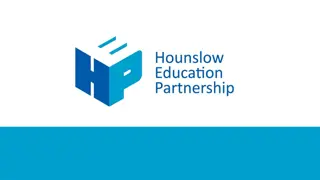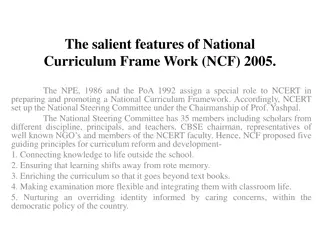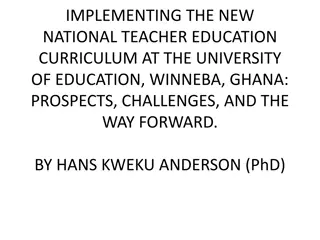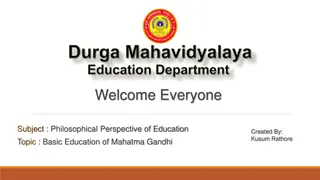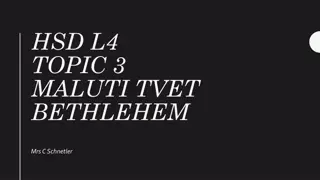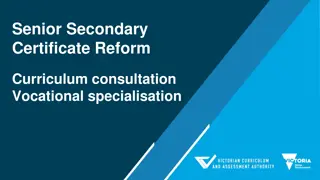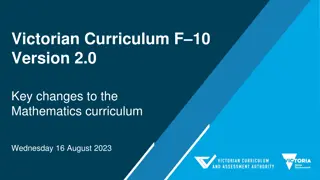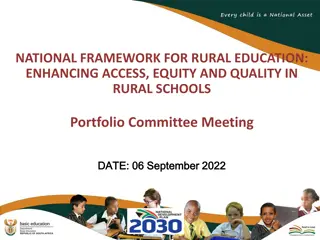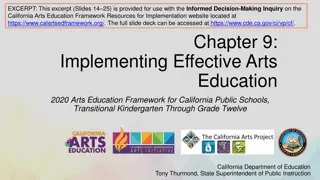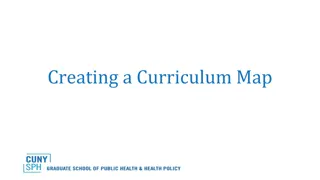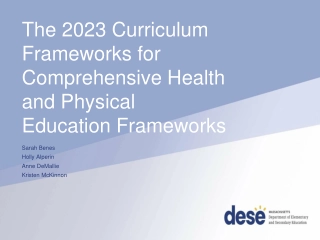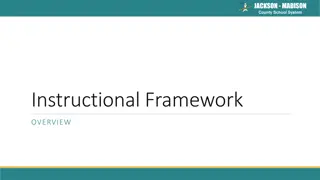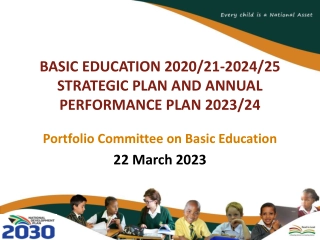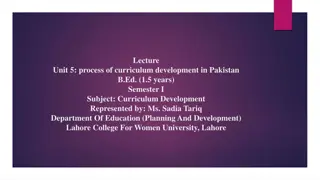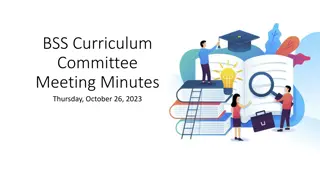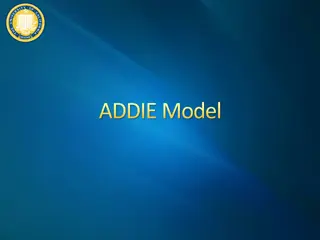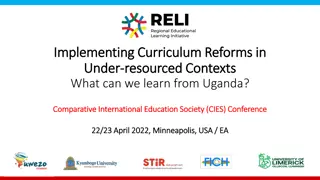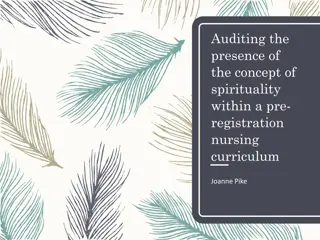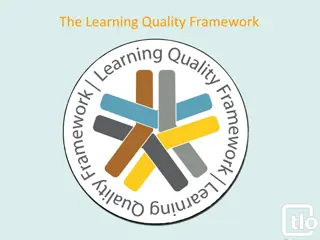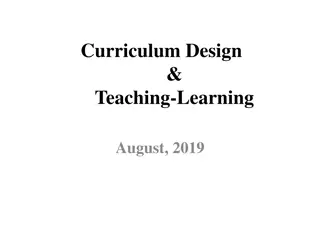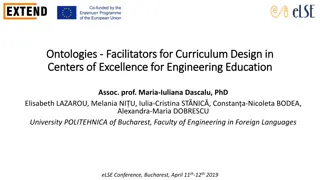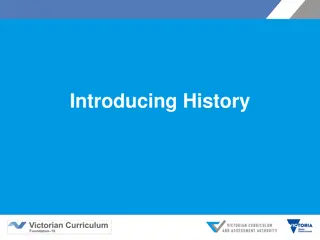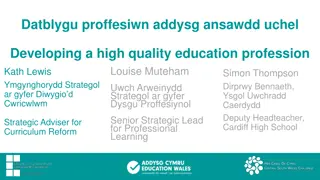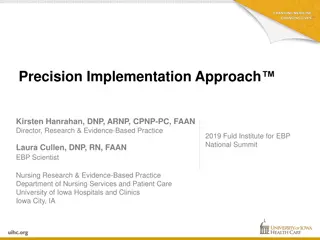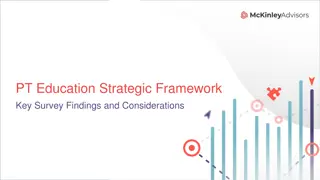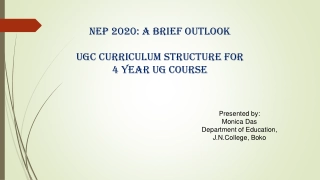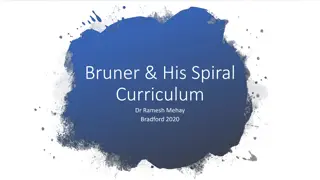Enhancing Basic Education Curriculum Framework for Effective Implementation
Explore the Basic Education Curriculum Framework, learning outcomes, key areas covered, suggested learning experiences, and vision statements for curriculum reforms in Kenya. Dive into the national goals of education, core competencies, and organization of basic education to empower educators and stakeholders in implementing an engaging and empowering curriculum.
Download Presentation

Please find below an Image/Link to download the presentation.
The content on the website is provided AS IS for your information and personal use only. It may not be sold, licensed, or shared on other websites without obtaining consent from the author. Download presentation by click this link. If you encounter any issues during the download, it is possible that the publisher has removed the file from their server.
E N D
Presentation Transcript
Basic Education Curriculum Framework
Session Outcomes By the end of the session, the participant should be able to: a) Discuss the Basic Education Curriculum Framework to professionally implement the curriculum b) Appreciate the Basic Education Curriculum Framework for effective implementation of curriculum
Key Areas to be covered Basic Education Curriculum Framework Vision and Mission statements National Goals of Education Pillars of BECF Core Competencies Organization of Basic Education Learning areas for EYE
Suggested Learning Experiences Buzz on the Mission and mission statements Reflect on the national goals of education Brainstorm on the importance of the core competencies Discuss the organization of basic education Question and answer
Curriculum Reforms Vision Statement Engaged Empowered Ethical citizen.
Curriculum Reforms Vision Statement The vision of the basic education curriculum reforms is to enable every Kenyan to become an engaged, empowered and ethical citizen. This will be achieved by providing every Kenyan learner with world class standards in the skills and knowledge that they deserve, and which they need in order to thrive in the 21st century. This shall be accomplished through the provision of excellent teaching, school environments and resources and a sustainable visionary curriculum
Vision Statement ( cont..) In order to do this, there is need to develop teachers who are: Highly knowledgeable Reflective Professional Possessing additional enhanced skills Confident in a range of modern pedagogical like coaching, facilitating, and mentoring
Vision Statement ( cont..) Therefore the reformed curriculum seeks to ensure that the next and future generations of Kenyan citizens shall be : Patriotic and global Equipped with the skills, knowledge, attitudes and values to thrive in the modern world Confident about their proud and rich cultural heritage and contributing this heritage to make the world a better place for everyone.
Curriculum Reforms Mission The mission of the basic education curriculum reforms is nurturing every learner s potential .
Curriculum Reforms Mission (cont..) The curriculum will be designed to ensure that it provides opportunities to identify the potential that every learner brings to school and nurture this potential through the learning pathways and tracks that will be provided at Senior School. The mission will ensure that no child is labelled a failure at the end of basic education.
National Goals of Education The Framework will be anchored on the National Goals of Education: Education in Kenya should: 1. Foster nationalism, patriotism, and promote national unity Kenya s people belong to different communities, races and religions and should be able to live and interact as one people. Education should enable the learner acquire a sense of nationhood and patriotism. It should also promote peace and harmonious co- existence.
National Goals of Education ( Cont..) 2. Promote social, economic, technological and industrial needs for national development Education should prepare the learner to play an effective and productive role in the nation by:- Instilling social and adaptive skills in the learner for effective participation in the family, community, national, regional and international development. Preparing a learner with requisite competences that support a modern and independent growing economy Developing in the learner necessary competences for technological and industrial development for the nation in tandem with global trends
National Goals of Education ( Cont..) 3. Promote individual development and self-fulfilment Education should provide opportunities for the learner to develop to the fullest potential. This includes development of one s interests, talents and character for positive contribution to the society. 4. Promote sound moral and religious values Education should promote acquisition of national values as enshrined in the Kenya Constitution. It should be geared towards developing a self-disciplined and ethical citizen with sound moral and religious values
National Goals of Education ( Cont..) 5. Promote social equity and responsibility Education should provide inclusive and equitable access to quality and differentiated education; including for learners with special educational needs and disabilities. Education should also provide the learner with opportunities to develop and practice shared responsibility and accountability through community service learning.
National Goals of Education ( Cont..) 6. Promote respect for and development of Kenya s rich and varied cultures Education should instill in the learner appreciation of Kenya s rich and diverse cultural heritage. The learner should value own and respect other people s culture as well as embrace positive cultural practices in a dynamic society.
National Goals of Education ( Cont..) 7. Promote international consciousness and foster positive attitudes towards other nations Education should empower the learner to respect, appreciate and participate in the opportunities within the international community. Education should also enable the learner to operate within the international community with full knowledge of the obligations, responsibilities, rights and benefits that this membership entails.
National Goals of Education ( Cont..) 8. Promote positive attitudes towards good health and environmental protection Education should inculcate in the learner the value of physical and psycho-social well- being for self and others. It should promote environmental preservation and conservation, including animal welfare, for sustainable development.
Pillars of B.E.C.F The basic education curriculum framework vision and mission are supported by three important pillars:- Values based education Guiding principles Theoretical approaches
1. Values based education Values are defined as standards that guide an individual on how to respond or behave in a given circumstance. In a State of the Nation address, the Kenyan President directed that values should be taught at every level of the education system and that the work of mainstreaming ethics and integrity awareness in the public and private education curriculum should be expedited (Nation Reporter, 2015)
Values based education ( Cont..) The values that will be taught in basic education are:- Love Respect Responsibility Unity Peace Patriotism Social justice Integrity
2. Guiding principles The Framework is based on the following guiding principles: Opportunity Excellence Diversity and Inclusion Differentiated Curriculum and Learning Parental Empowerment and Engagement Community Service Learning
Opportunity: Learners will be given a variety of opportunities to identify their needs, talents, and potential so that they can participate in the world of work and the development of the nation. The emphasis is on equal access to education for all, ensuring that learners enjoy learning and find it relevant.
Excellence Learners will be nurtured to excel in their areas of greatest aptitude and ability. The Framework values excellence rather than competition for examination grades
Diversity and Inclusion Learners will be guided to appreciate Kenya s diversity in terms of race, ethnicity, gender, language, culture, and religion. It also respects learners different needs and abilities, valuing these within an inclusive learning environment. All learners will be accommodated, regardless of their physical, emotional, intellectual, or any other need. The Framework recognizes the different academic abilities of learners, considers individuals social and cognitive capabilities, needs and desires, and respects differences in the way children learn. The ultimate aim is to guarantee basic education for every learner according to their abilities and needs.
Differentiated Curriculum and Learning Building on the principle of diversity and inclusion, the Framework ensures that curriculum content and instructional approaches are appropriate for all. It provides flexibility for teachers to adapt the curriculum to suit individuals and does not demand that every learner should learn the same content, in the same way, in the same number of hours, and at the same time.
Parental Empowerment and Engagement Parents play a very important role in determining the success of their children s education. They have a shared responsibility with schools to provide an enabling environment that is conducive to learning and motivates learners to fulfill their potential. The Framework provides opportunities for schools to empower parents to contribute to their children s learning outcomes and to be engaged at all levels of their basic education.
Community Service Learning Community Service Learning enables learners to apply their knowledge and skills while addressing real needs in the community. It integrates meaningful community service with instruction and reflection to enrich the learning experience, teach civic responsibility and strengthen communities. Learners will work on real problems in order to make their academic learning relevant, while at the same time enhancing their social skills, analytical ability, civic and ethical responsibility, self-efficacy, and career development. Teachers will need to help learners to analyse what they have learned through participating in community service and how to apply what they have learned to their academic and personal development.
3. Theoretical approaches To ground the conceptualization and design of the curriculum on sound education and curriculum principles, the Framework is guided by several theories, including: Vygotsky s social-cultural development theory, the primary focus of which is on supporting students through scaffolding the learning experiences. Piaget s cognitive development theory, which will mainly provide the alignment between the maturational development of the child and how learning should be organized. Bruner s cognitive development theory, which emphasises the importance of organizing learning in a meaningful way to build from the known to the unknown. John Hattie s Visible Learning that emphasises the role of the teacher in terms of the impact the approaches adopted may have on students learning. Dewey s social constructivism that focuses on the need to adopt learner- centred approaches in curriculum design and delivery.
Core competencies Based on the Needs Assessment Study carried out by KICD, and the vision and mission of the BECF, the seven core competencies to be achieved by every learner in basic education are: Communication and collaboration Critical thinking and problem solving Creativity and imagination Citizenship Self-efficacy Digital literacy Learning to learn
Communication and collaboration Communication: Exchange of ideas in class (teacher to learners, learner to teacher and learner to learner) Learners answering or asking questions Learners discussing in pairs or groups Expressing thoughts and ideas Learners writing on the blackboard or in their books Debates Collaboration: Working together Group work Team work Cooperation Partnership Sharing
Critical thinking and problem solving An important outcome of quality education is teaching learners how to think critically. The British Council (2015) identifies three types of thinking: reasoning, making judgment, and problem solving. When learners are empowered with critical thinking, they avoid being subjective, and use logic and evidence to arrive at conclusions. Critical thinking also facilitates exploring new ways of doing things and learner autonomy. Learners learn that for every issue there are multiple perspectives that they can explore, rather than a rigid recall and regurgitation of information. For example, at pre-primary school level learners can be asked to come up with the best ways of using and keeping their books, stationery and other personal items safe.
Creativity and imagination Creativity and imagination refers to the ability to form new images and sensations in the mind, and to turn them into reality (British Council, 2016). Creativity and imagination is characterized by the ability to perceive the world in new ways, to find hidden patterns, to make connections between seemingly unrelated phenomena, and to generate solutions. It is a phenomenon whereby something new and valuable is formed. Learners who are imaginative and creative are able to make life interesting for themselves and others around them.
Citizenship Good citizenship includes: - Doing your best in school making responsible decision, caring about others ,contributing to society Developing social and personal skills such as reflective problem solving, accepting a variety of perspectives, setting and attaining goals. In class, good citizenship may include but not limited to: i. Communicating with other people with respect for their opinions and feelings. ii. Collaborating with others without discrimination. iii. Contributing to the general progress of others
Self-efficacy Self-efficacy is the ability of a learner to define a goal, persevere, and see oneself as capable. It is the belief that you have skills that you can rely on to help you navigate life and reach your goals (National Association of School Psychologists, 2010).
Digital literacy Digital literacy is the set of competencies required for full participation in a knowledge society. It includes knowledge, skills, and behaviors involving the effective use of digital devices such as smartphones, tablets, laptops and desktop PCs for purposes of communication, expression, collaboration. Using an interactive whiteboard in the classroom for lessons and allowing learners to use the interactive whiteboard on a daily basis. Encouraging learners to use technology to showcase their learning. Using the web ( web sites video, music) to enhance the learning of your pupils. Pupils and teachers creating online content to be utilized both in and out of the classroom.
Learning to learn Learning to learn is the ability to organize one s own learning including through effective management of time and information both individually and in groups (Hoskins & Fredriksson, 2008). This basically involves applying what has been learnt to new situations. In classroom situation, it may involve: i. Planning time to get information from written materials, media, peers,and knowledgeable people and using it. ii. Discussing ideas with peers
Basic Education will be organized into three (3) levels: Early Years Education Middle School Education Senior School
Essence statements These are statements that give the core of the subject and its importance. Rationale of why we are doing E.g. Essence Statements for the Pre-primary Curriculum Language Activities: Language is an important tool for facilitating learning as children use it to interact with their immediate environment. The essence of this activity area is to develop oral, reading readiness and writing readiness competencies in order to lay the foundation for language acquisition.
Early Years Education (EYE) This shall comprise:- Two years of pre-primary Three years of lower primary school education.
Learning area for Early Years Education- Pre Primary Education Lessons Per Week Learning area 1 Language Activities 5 2 Mathematical Activities 5 3 Environmental Activities 5 4 Psychomotor and Creative Activities Religious Education Activities 8 ( 5 outdoor activity 2 (1 PPI) 5 Total No of Lessons per week 25
Learning areas - Lower primary Education Lessons Per Week Learning area 1 Literacy Activities and Indigenous Languages5 2 Kiswahili Language/KSL for the deaf 3 3 5 5 2 3 8 (5 for PE) 1 35 3 English Language Activities 4 Mathematical Activities 5 Environmental Activities 6 Hygiene and Nutrition Activities 7 Religious Activities(CRE,IRE,HRE) 8 Movement and Creative Activities 9 Pastoral Programme of Instruction Total No of Lessons per week
Strengths of C.B.C Learner-focused Focus on Competencies Opportunities for Local Decision Making and Greater Depth of Study Balance Between Formative and Summative Assessment Digitally Based Collaborative and Co-development Models Encourages interdisciplinary learning


